Weaving the Tequila Sunrise Scarf – Blog Post
Learning to weave can be exciting, challenging and rewarding. All of us have been beginning weavers at the beginning of our weaving careers, and many of us have forgotten how fresh and exciting, and intimidating that experience can be. We Lunatics are fortunate to have some new, young weavers in the shop, and we wanted to give our new weavers some time to talk about their experiences as they learn about weaving.
Amber is our warehouse manager, and if you have received a package from us recently, she probably had a hand in that package making its way to your door. She would like to tell you about her experiences weaving the Tequila Sunrise colorway of the Chameleon scarf. Amber helped to select the colors that we put into this colorway, and we wanted her to warp and weave the scarf as she learned more about weaving. Some of the time we were there to help, and sometimes she was on her own learning about the Flip Rigid Heddle Loom and 3 strands of 10/2 Tubular Spectrum™ mercerized cotton yarn.
Weaving into a Tequila Sunrise
by Amber H.
Hello fellow weavers, it’s Amber here. I am a beginner weaver with a lot of crochet experience. This past year has been full of new experiences as I have learned to weave on a rigid heddle loom. I knew nothing about weaving a year ago! At first, I was so intimidated by all the little details about weaving. However, I was hooked the minute I realized how quickly projects can be completed while using a Rigid Heddle loom versus crocheting.
Since I began weaving this year, I have made a few washcloths, a cowl, and three scarves, including the two Chameleon Scarves in the Tequila Sunrise Colorway described below. I can’t wait to explore the weaving world a bit more and use other yarns and techniques!
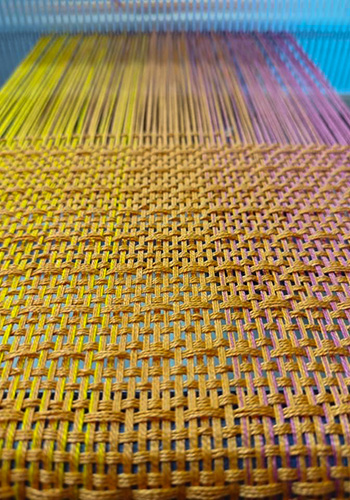
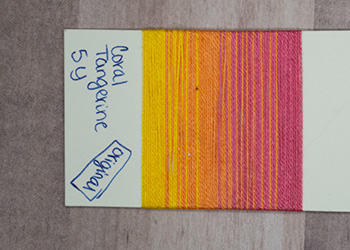
Wrap it up!
Before warping my loom, I made a color wrapping using the three colors of 10/2 Tubular Spectrum™ Yarn that are used in the scarves. It helped me understand how the colors change within the warp. I used a piece of cardboard or cardstock, something sturdy and wrapped the yarn in sequence per instructions. That color wrapping was my friend as it helped me understand the pattern. When I started to warp up the loom, it was like I was creating a sunrise but with yarn. It was beautiful to the eyes.
Check, Check and Triple Check!
During this project, I learned to check the center of the reed, double check how big the project is supposed to be and triple check to make sure that I have the correct reed when I start my projects.
While starting to read the pattern, I did not realize there were two scarves that can be woven: one woven in plain weave and one woven in lace weave. The plain weave scarf uses an 8-dent reed, and the lace weave scarf uses a 10-dent reed. However, I didn’t pay close attention to that detail and found myself using a 10-dent reed and using the plain weave scarf pattern directions. Whoops! A mismatch! I have since learned that the reeds change depending on whether it is plain weave or lace weave because of the ends per inch (EPI). The plain weave scarf requires more space between the warp threads (8-dent reed) so that it will finish as a flat scarf. The lace weave pattern calls for a finer reed (10-dent reed) because I make floats in the fabric with a pickup stick and create the lace texture.
I had used a small piece of string to mark the center of my 10-dent reed. That way I could figure out how far I went on each side of the reed to make sure things were centered. This would have worked great, except that I was using the 10-dent reed and following the directions for the plain weave scarf (the mismatch), so my warp came out unevenly in the reed. Once I realized the mismatch, I decided to warp up the right number of ends for the lace weave scarf and cope with the slightly unbalanced reed. It wasn’t a huge problem, but it made weaving the first scarf a bit more challenging. I had to hold the reed just right to beat straight.
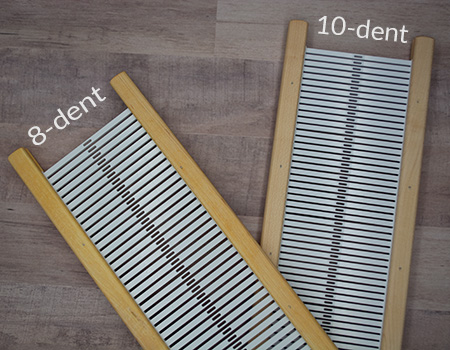
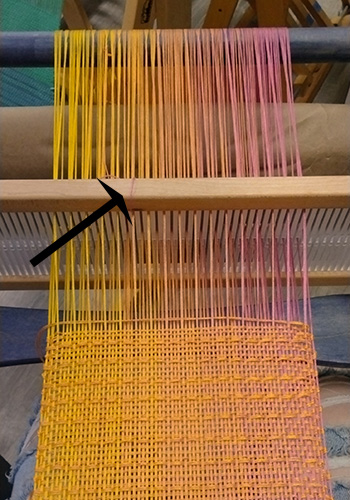
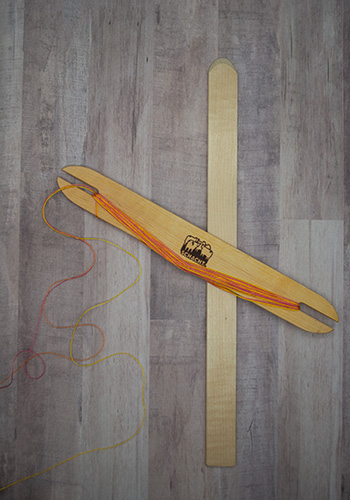
Prepare the Sticks – Shuttles and Pickup!
For both the warp and weft in these scarves, I used 3 strands of 10/2 Tubular Spectrum™ Yarn. I used those three strands just like one thread. Changing one strand at a time makes the colors shift throughout the scarf.
Before I began weaving the first scarf, I wrapped my estimated weft yardage onto a stick shuttle. The stick shuttle helped me focus on my tension more than using a boat shuttle.
I also had to insert a pickup stick in the warp, behind the reed. The pickup stick lifts certain strands of warp yarn throughout the lace weave scarf. The pattern specifies which ones to pick up and when to use it as I wove. The pickup pattern provides bold characteristics to the scarf, giving it more texture. I enjoyed weaving the lace pattern. It was fun and exciting to watch as the colors changed and interlaced.
Count My Picks!
When I began weaving on the first scarf, I was having a hard time meeting the picks per inch (PPI) requirements. This means how many picks of weft I weave per inch. I tend to want to just cruise along. However, I had to unravel a bit and start again because I had to figure out how hard to beat in order to accomplish the required PPI. In crochet, I am guilty of not counting my stitches and I found myself in this same predicament. It is most definitely something I am making myself focus more on.
When changing colors, I also had to be aware of how much of each color is used for each section. Luckily, the pattern provided all of that for me. All of this counting is important so that I get the end results I am looking for.
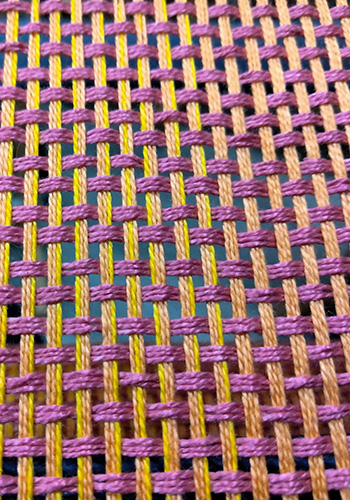
Plain Weave is Fast!
After finishing the lace scarf, I cut it off the loom and changed reeds so I could begin the plain weave scarf. I then began re-warping the loom. The EPI and PPI were different for this plain weave scarf. I remembered the 8-dent reed this time! And marking the center of the reed worked great to get the plain weave scarf centered in the 8-dent reed! The whole scarf worked up much faster, weaving in plain weave, because there was less to focus on. It was smooth sailing. I felt had more confidence starting the plain weave scarf. It is good that the instructions have the plain weave scarf first, even though I didn't weave it first!
I forgot to hem stitch at the beginning and didn't realize it until I took the scarf off the loom. I was able to do the hemstitching when I had completed the scarf, and I don't think anyone would even notice that I did it after it was off the loom! These scarves are pretty! I enjoy the bold look of using multiple strands of 10/2 Tubular Spectrum™ yarn in my warp and in my weft.
In Conclusion, I Love Both Scarves.
I enjoyed how quickly the plain weave scarf whipped up. If you like a calm steady pace, I’d recommend doing the plain weave scarf first. The lace weave was more challenging. However, I enjoy a good challenge. I personally enjoyed the bold pattern that the lace weave gives.
I also enjoyed the calm color transition that happens as you weave the scarves and spreading my wings a bit more with weaving even if I started with the more complex version first. I think the trickiest part of it all was getting my warp on and getting ready to weave. Trying to remember the details as to getting everything on and in place, as well as knowing when to change colors was the most challenging part. My favorite part of making these scarves was being able to see the colors transform and interlock. Yarn works so differently, together, in weaving than it does crocheting. Lastly, I hardly had any yarn left over! It was a fun experience learning how to make colors fade just as a sunset would.
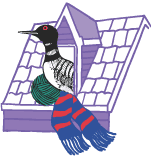

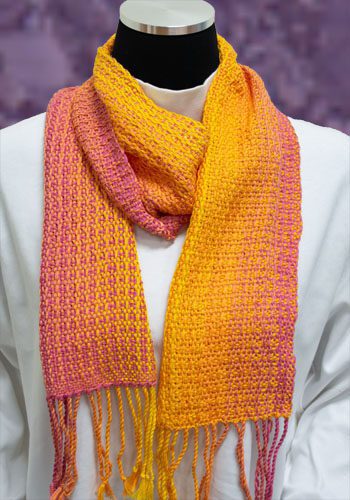
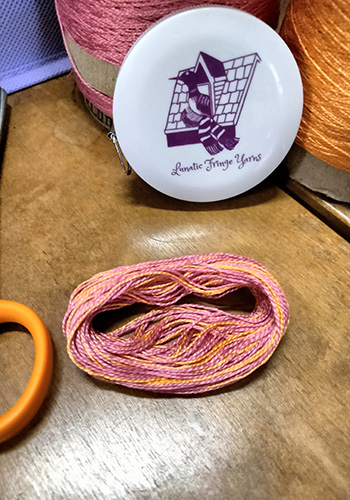
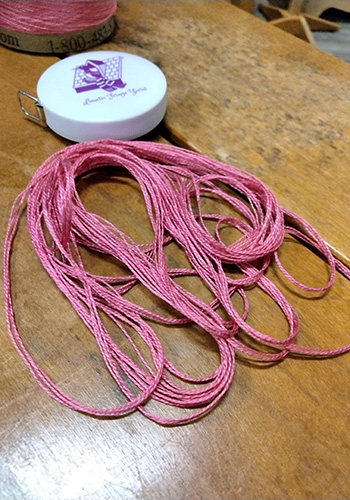
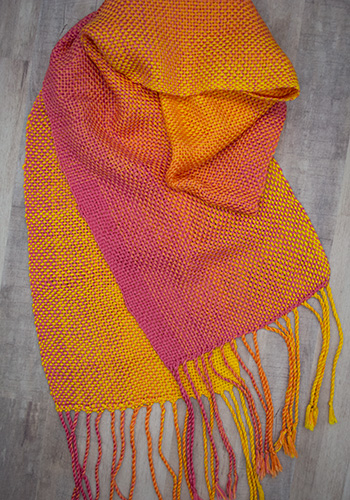
Very pretty. You are lucky to be able to work with such a fun and talented team, I’m jealous.